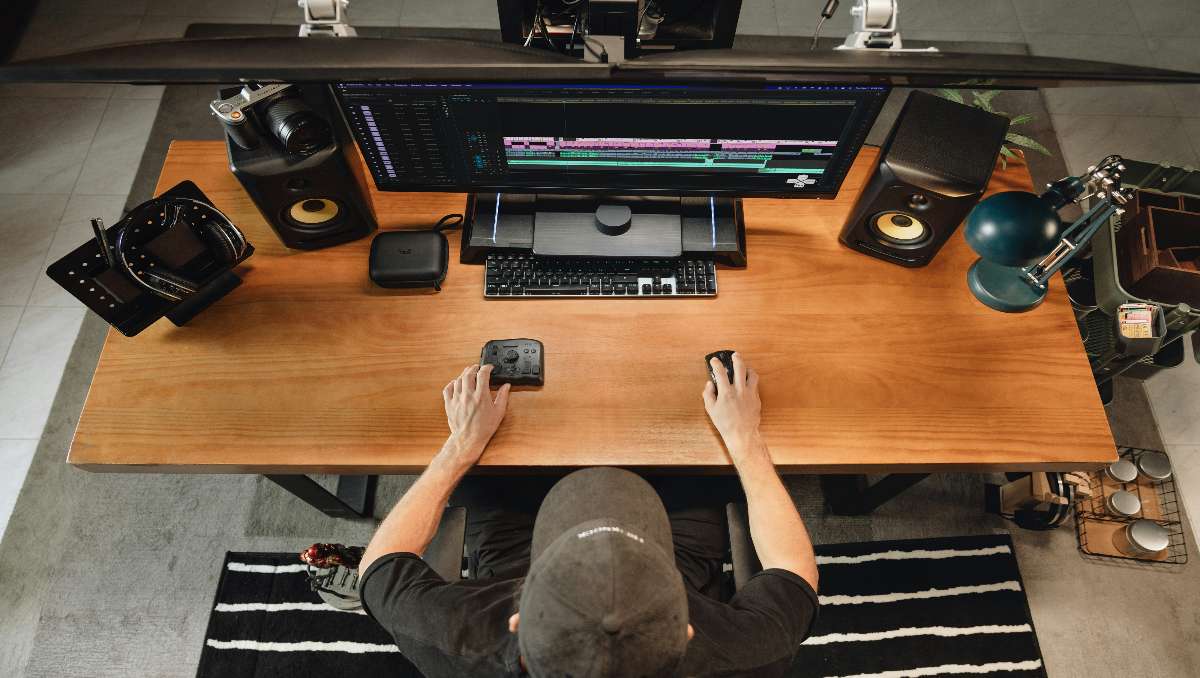When it comes to setting up an ergonomic and comfortable workspace, many factors come into play, from the height of your chair to the position of your monitor. But one often overlooked detail is the minimum desk depth. Finding the right desk depth is crucial, as it directly impacts your comfort and productivity throughout the day.
Key Takeaways:
- For a comfortable and ergonomic setup, go for a desk that’s at least 24 inches deep—30 inches is even better if you want extra space for gear and better monitor distance.
- Choose a desk depth that fits your tasks and body size. Taller people or those with specific tasks may need more space.
- Make sure your desk depth works with the space available.
In this article, we’ll take a closer look into why the minimum desk depth matters, how to determine what works best for you, and how to create an ideal workspace that promotes both health and efficiency.
What is Desk Depth and Why It Matters for Comfort?
Desk depth is more important than it may first appear. It’s the measurement from the front to the back edge of your desk, and it has a big impact on comfort and ergonomics. A desk with the right depth gives you enough room to place your keyboard, mouse, and other essentials comfortably, allowing your wrists and forearms to rest naturally. This helps prevent awkward angles that could lead to strain over time. Desk depth also affects how your arms and wrists align with your desk height, and it plays a key role in how you position your monitor for the best viewing angle.
If your desk doesn’t have enough depth, it can lead to a host of problems. A shallow desk often forces you to keep your keyboard and mouse too close to the edge, which can strain your wrists and force you into uncomfortable postures. On top of that, a lack of depth can make it hard to organize your workspace effectively, leading to clutter and making it difficult to access important documents or tools. All of this can negatively affect your productivity and overall comfort while working.
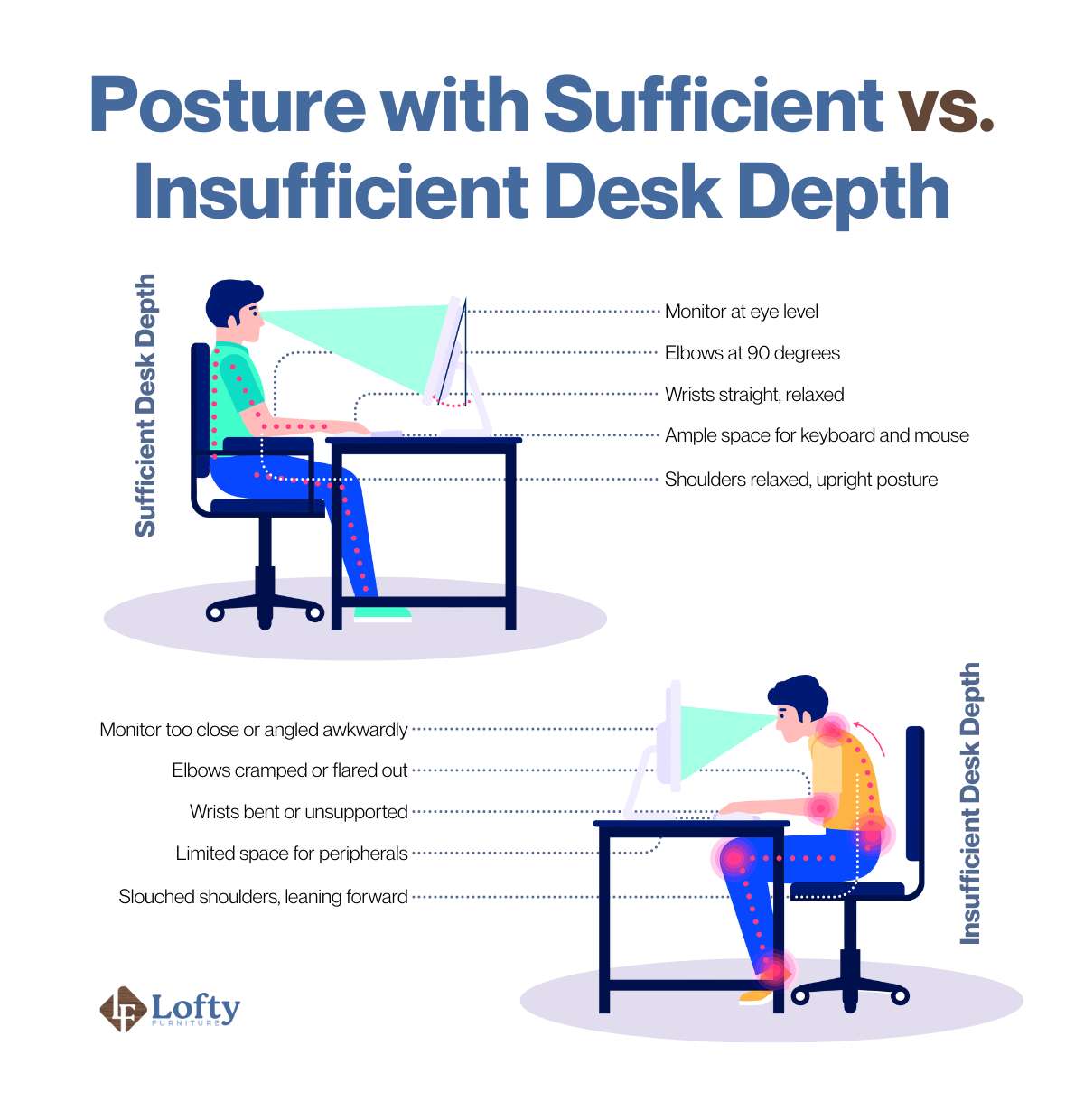
Finding Out the Minimum Desk Depth For Your Comfort
Establishing the ideal minimum desk depth isn’t a one-size-fits-all equation. Several factors come into play, all of which should be carefully considered.
Intended Use of the Desk
The type of work you do at your desk plays a big role in how deep your desk needs to be. If you mostly use a laptop, you might get by with a shallower desk than someone who regularly uses a full-sized keyboard. For tasks like writing or handling detailed paperwork, you’ll need enough space to spread things out comfortably without feeling cramped. Think about all the activities you’ll be doing at your desk to figure out the minimum depth that will let you work efficiently.
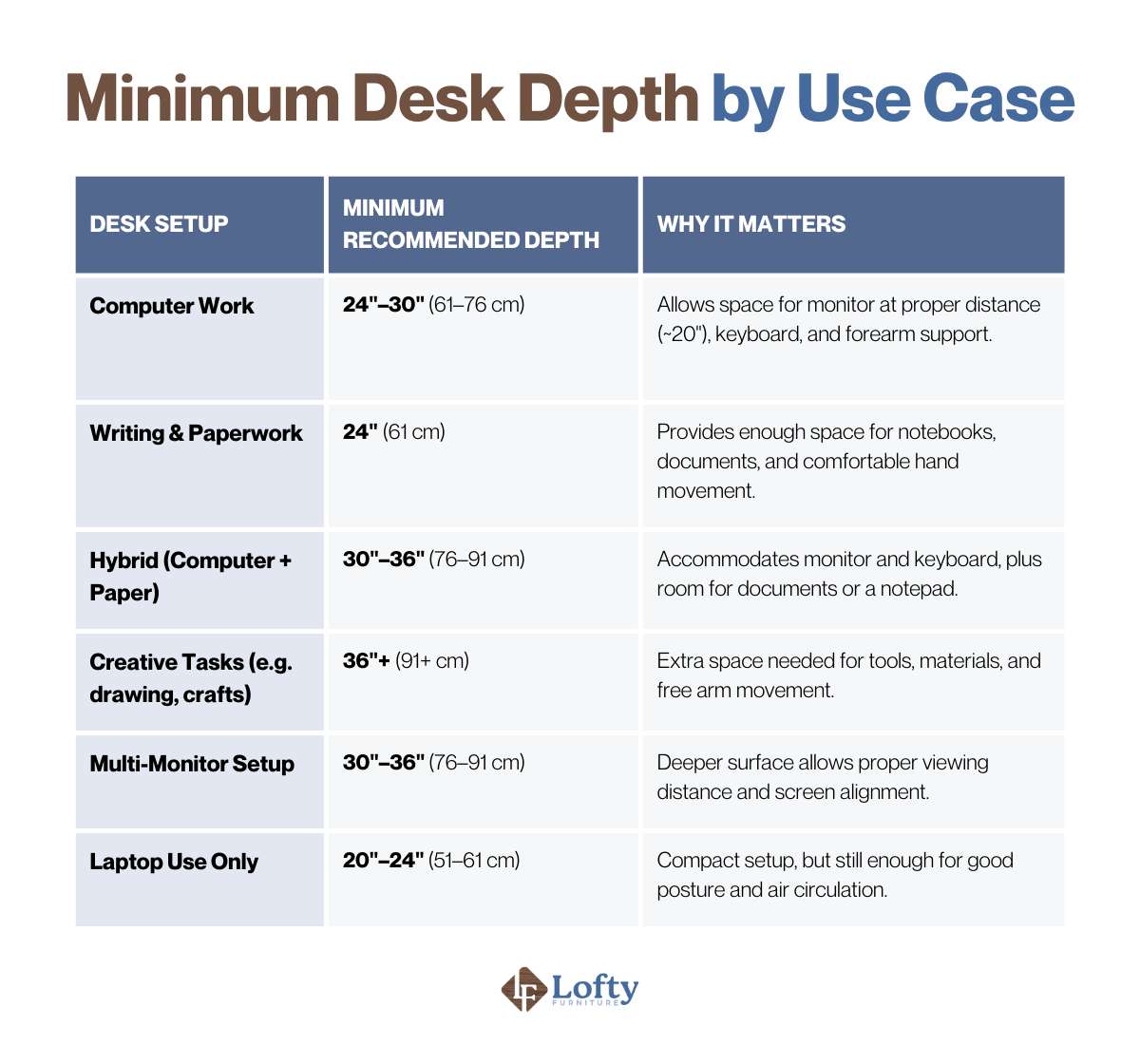
User Height and Body Dimensions
Individual body dimensions, particularly the length of your arms and torso, play a crucial role in determining the standard desk dimensions. Taller individuals with longer arms will generally require a deeper desk to comfortably reach their monitor and have adequate space for their forearms to rest while typing. Consider your unique physical attributes to ensure the desk depth allows for a neutral and comfortable working posture.
Available Space and Room Layout
When deciding on desk depth, the size of your workspace is an important factor to consider. While ergonomics can guide you toward an ideal desk depth, the layout and size of your room may limit your options. In a small office or shared space, you might need to go for a shallower desk to ensure there’s enough room to move around and avoid the area feeling too cramped. It’s all about finding a balance between comfort and making the most of your space.
The Recommended Minimum Desk Depth
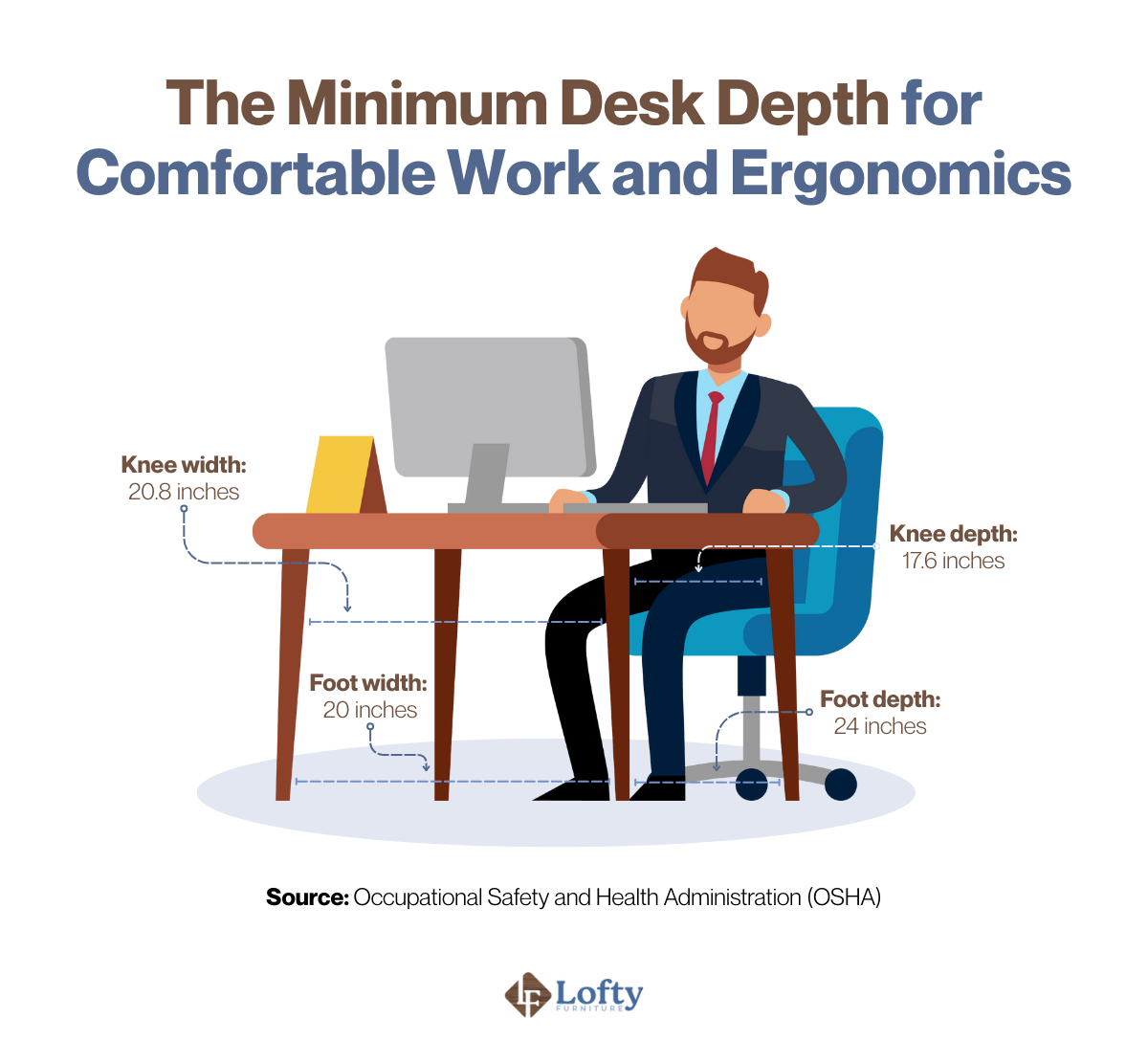
While individual needs vary, several guidelines and expert recommendations exist to help determine a comfortable and ergonomically sound minimum desk depth. According to OSHA, the minimum under-desk clearance depth should be 17.6 inches for knees and 24 inches for feet. Furthermore, they recommend a minimum clearance width of 20.8 inches at knee height and 20 inches at foot height. These measurements highlight the necessity of sufficient depth not only for placing items on the desk surface but also for ensuring comfortable posture and movement while seated.
To give you a clearer picture of how different desk depths affect comfort, here’s a comparison based on common ergonomic guidelines and sources.
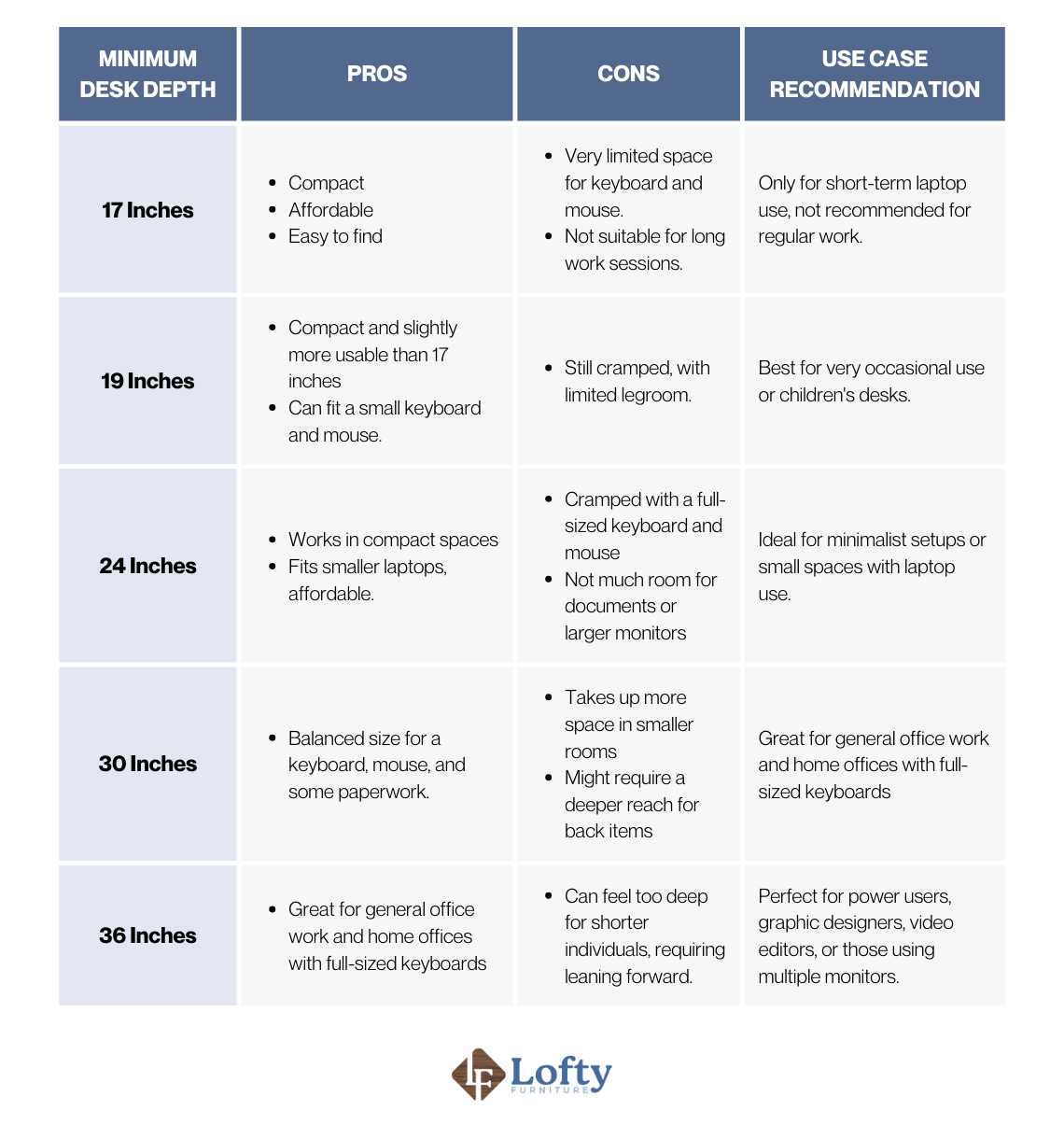
How to Optimize Desk Depth for Better Ergonomics
- Monitor Placement: Position your monitor about an arm’s length away from you, with the top of the screen at or slightly below eye level. This helps reduce neck strain and promotes a more natural viewing angle.
- Keyboard and Mouse Setup: Ensure there’s enough space on your desk to comfortably place your keyboard and mouse. Your wrists and forearms should rest naturally on the desk to avoid strain while typing or using the mouse.
- Utilize Desk Depth: If your desk has extra depth, use the back area to store less frequently used items. This keeps your immediate work zone clear and organized, making it easier to focus on your tasks.
- Space-Saving Solutions: If space is tight, consider using a monitor arm to adjust the screen to the right height and distance. A keyboard tray can also help improve wrist alignment and free up space for a more efficient desk setup.
- Chair Adjustments: Make sure your ergonomic desk chair is properly adjusted for the correct height and depth. This ensures you have enough legroom and proper back support, both of which are essential for maintaining comfort and good posture.
- Cable Management: Organize your cables under and behind the desk to keep them out of sight and reduce clutter. This maximizes the usable surface of your desk and helps maintain a tidy, efficient workspace.

Considering the importance of adequate desk depth for a comfortable workspace, why not explore a Lofty height adjustable desk? Experience the flexibility to optimize your setup for any task and posture.
Finding Your Ideal Desk Depth for Comfort and Productivity
Ultimately, determining the minimum desk depth for comfortable work and ergonomics is a balancing act between available space, the nature of your tasks, and your individual physical dimensions. While guidelines and recommendations offer a valuable starting point, the most crucial factor is finding a depth that allows for a neutral and relaxed posture, sufficient space for your essential tools, and comfortable monitor placement.
FAQs
Is the standard desk depth always ergonomic?
While a desk depth of around 24 to 30 inches is often considered “standard,” it’s not universally ergonomic. Ergonomics depend on individual needs and how the desk depth accommodates proper posture, reach, and monitor placement, not just a standard measurement.
What is the best size for a desk?
When choosing the best desk size for your workspace, medium desks—ranging from 40″ to 60″ wide—are the most common and versatile, fitting well in most rooms. If you need more surface area for multiple monitors or equipment, a large desk 60″ wide or more is ideal.
Can using desk accessories compensate for a desk with insufficient depth?
While accessories like monitor arms and keyboard trays can help mitigate some issues arising from insufficient desk depth, they are not a complete substitute for an adequately deep desk. These accessories are best used to optimize a reasonably sized desk, not to entirely compensate for a severely shallow one.
What are the signs that my desk depth is not ergonomic?
Several signs can indicate that your desk depth is not ergonomic. These include constantly feeling cramped, having insufficient space to rest your wrists while typing, frequently bumping into the front edge of the desk, and experiencing neck or shoulder pain due to awkward reaching or posture.
